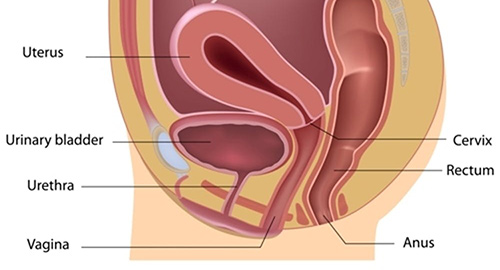Call Us
by Courtney Steele MScPT
Pelvic Physiotherapist
updated Dec 6, 2021
What is vaginismus?
Vaginismus is the involuntary contraction or spasm of your pelvic floor muscles in response to attempted penetration.
What are the symptoms of Vaginismus?
The hallmark feature of vaginismus is the inability to have vaginal penetration and the act of attempting to do so causing pain. Individuals with the condition will report feeling pain as well as “too tight” or “blocked” when attempting penetrative activities such as:
- insertion of a tampon
- vaginal ultrasounds
- PAP exams
- penetrative sexual intercourse
This differs from dyspareunia – a medical term used to describe painful penetration. The key difference being that vaginismus is an accommodation issue that also elicits pain. Whereas, with dyspareunia you are able to achieve penetration but it is painful (some common reasons for dyspareunia would include menopausal changes, postpartum, yeast infection or an STI).
Types of Vaginismus
There are two types of vaginismus: primary and secondary.
Primary Vaginismus – the inability to tolerate penetration from first attempt (i.e. first time attempting to insert a tampon or first attempt at penetrative intercourse). Vaginal penetration has never been achieved.
Secondary Vaginismus – when someone has previously been able to achieve penetration but is no longer able to do so.
What causes Vaginismus?
There is no one cause for vaginismus.
In primary vaginismus, there is often a strong link to emotions, beliefs, fears or anxiety. As the brain controls all functioning in our bodies, these emotions can create a protective response in our pelvic floor muscles, causing them to contract.
With secondary vaginismus, it is often due to a change, for example a recent negative experience involving a sexual encounter or medical exam; or the progression of a painful pelvic condition.
How do pelvic floor muscles contribute to Vaginismus?
Your pelvic floor muscles control your openings (urethra, vagina and anus). When they tighten, it constricts and closes these openings – this is what allows us to stay continent. However, the muscles need to relax to allow for movement both out (to urinate or have a bowel movement) and in (insertion of tampon, during intercourse or a PAP exam). With vaginismus, it is these muscles contracting in a protective response that blocks the ability to insert something into the vagina.
Who gets Vaginismus?
Because of the link to past experiences, emotions and beliefs vaginismus is more commonly seen in those who have:
- suffered sexual abuse or trauma
- been exposed to aversive sexual messaging (the suggestion the sex hurts, is a shameful act or is only done for procreation)
- had negative past experiences with medical exams/surgeries or procedures involving vaginal penetration
- had persistent pelvic pain or painful intercourse
How do you diagnose Vaginismus?
Vaginismus is diagnosed with a thorough medical and sexual history taking, and an external and attempted internal physical examination.
Discussing your history gives your health care provider significant insights to if you have past experiences that would contribute to a protective response of your pelvic floor. It will also help to rule out other potential conditions that would cause similar symptoms.
A pelvic exam can be a very stressful situation for patients but especially for those that experience pain with penetration. There is often a lot of fear about undergoing this component of the exam. A physical therapist who understands the drivers of vaginismus will be gentle, explain what they are going to do before they proceed and ensure you are in control of what happens in that assessment.
As a pelvic floor physical therapist, we will be observing the pelvic area for any notable tissue changes to ensure the pain isn’t coming from another condition. We will observe your ability to control your pelvic floor muscles (relax/contract), the muscles response to gentle touch and attempted penetration (single digit insertion, we do not use instruments like speculums).
If vaginismus is present, we will see and feel the spasm of the vaginal muscles. At that point we know what we are dealing with and there is no further need to continue the exam. So for those reading this that are nervous about seeking treatment, please be assured that an internal exam often isn’t fully completed in this session.
How is vaginismus treated?
As vaginismus is a physical response to an emotional driver, the most efficient and effective way to treat it is to address both of these areas.
Counselling will help you to work on the emotional drivers (thoughts/beliefs/past traumas) that are causing the physical spasm. This may be individual work, but often includes couples therapy/sex therapy if you are in a relationship. This allows your partner to be included so that they can understand what is happening, work together as a couple to find different ways to experience pleasure or intimacy without penetration and work through any negative emotions such as guilt or shame that can affect the overall relationship.
Pelvic floor physical therapy helps to treat vaginismus by addressing the physical response (i.e. the spasm). Although treatment would be individualized it will generally include:
Learning to relax your pelvic floor muscles
To do this we use breathing techniques, imagery and tactile cueing.
Graded exposure exercises
As there is a lot of fear, anticipation of pain, stress and anxiety that comes with penetration, we use the relaxation techniques you have learned above and apply those to the practical situation of penetration. “Graded” means we begin with the least threatening (i.e. just holding a finger at the opening of the vaginal canal) and work up to whatever your goals may be (i.e. to be able to undergo a PAP exam or have penetrative intercourse).
Stretching exercises
Once you are able to achieve penetration of a finger without pain, we will work gently on getting those muscles to stretch. This is done by doing exercises with your finger and eventually working up to bigger items such as dilators. This will allow you to slowly progress, getting your muscles used to stretch in a non-painful way and build your confidence to be able to tolerate insertion of whatever your goal is.
Vaginismus treatment near me
If you are suffering with vaginismus or other sexual pain disorders, you are not alone, it can get better and we are here to help. Our pelvic floor physical therapists can provide medical advice and successful treatment strategies. We have locations in downtown Toronto, North York and Burlington. Contact us today to learn more.

Questions? We're happy to help!
Choosing the right service provider can be a big decision. We’re dedicated to answering any questions you have to help you make the best choice. Contact us today and ask us anything!
Call us at (416) 238-6749



